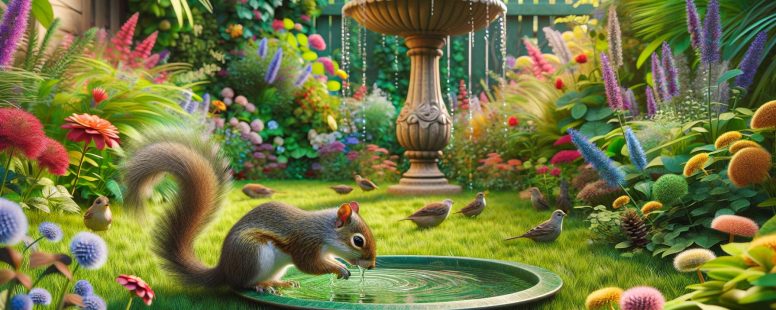Create a Squirrel-Friendly Yard: Safe Havens & Water Tips
Creating a safe haven for wild squirrels in your backyard isn’t just a kind gesture; it’s a step towards nurturing local wildlife. These bushy-tailed creatures are a joy to watch, but they need a secure habitat to thrive. You’re about to learn how to transform your outdoor space into a squirrel-friendly zone.
From providing the right food to understanding the importance of natural shelter, you’ll discover the essentials of squirrel welfare. Ensuring a safe environment for squirrels not only benefits them but also enhances the natural balance of your garden ecosystem.
Provide the Right Food for Squirrels
Offering appropriate nourishment is key to maintaining a squirrel-friendly yard. Your backyard visitors require a diet that supports their health and energy needs. Squirrels are naturally omnivorous, meaning they’ll eat both plant-based foods and small insects. While some might believe that any food will suffice, that’s not the case – certain foods ensure they remain healthy and thriving.
What to Feed
Aim to mimic a squirrel’s natural diet to prevent nutritional imbalances. Here’s what you can include:
- Nuts: Unsalted peanuts and acorns provide good fat sources.
- Seeds: Squirrels enjoy sunflower seeds and pumpkin seeds.
- Vegetables: Leafy greens like spinach and kale are nutritious options.
- Fruits: Apples, bananas, and grapes can be a sweet treat for them.
Rotate these foods to give squirrels a well-rounded diet. You can also provide specially formulated squirrel food available at pet stores, which is designed to be a complete meal.
Foods to Avoid
Some foods can be harmful to squirrels and should always be excluded:
- Junk food such as chips or candies
- Processed meats
- Dairy products
These items are not only unhealthy for squirrels but can also attract unwanted pests to your yard.
- Place food in a quiet area of your garden to allow squirrels to eat without disturbance.
- Use a squirrel feeder to keep food off the ground, reducing the risk of attracting rodents.
- Maintain a consistent feeding schedule to help local squirrels establish a reliable food source.
A harmonious balance of the right foods will give squirrels the energy they need while ensuring they are an enjoyable presence in your yard. Not only will you be supporting their health, but you’ll also be playing a part in the well-being of the local wildlife ecosystem.
Create Natural Shelter for Squirrels

When you’re aiming to provide a safe environment for wild squirrels, natural shelters are key. Squirrels need a cozy place to escape predators, harsh weather, and to raise their young. By mimicking their natural habitat, you give these critters the best shot at a secure home base in your backyard.
Start by observing the trees available in your yard. Squirrels are fond of tall trees with dense canopies that offer protection. If you’ve got large trees, you’re already ahead of the game. But even if you don’t, there are ways to compensate.
Here are some practical steps for creating natural shelters:
- Leave snags standing: If it’s safe, leave a few dead trees as is. They’re perfect nooks for squirrel nests.
- Hollowed Logs: Positioning a hollow log or two around the yard provides an excellent hideout for ground squirrels.
- Brush Piles: Gather branches and tree limbs into a pile to mimic debris found in forests. This provides cover and a spot for squirrels to nestle.
- Dens in the Ground: For species that prefer the ground, consider safe spots where they can dig and create a den.
Consider planting bushes and shrubbery that offer additional concealment. These plants create natural corridors for squirrels to move safely and stealthily. Plant them in clusters and close to trees and other shelters to promote a squirrel-friendly landscape.
Installing a squirrel house can also provide a supplementary option for shelter. Ensure it’s well-constructed, weatherproof, and placed high off the ground. Fill it with natural materials like leaves or twigs, so it feels as inviting as a tree hollow.
Remember, patience is your friend when waiting for squirrels to take up residence in the shelters you’ve provided. It might take some time, but with the right setup, they’ll soon explore and settle in. Keep their pathways clear, and the shelters maintained, so your backyard remains a welcome haven year-round.
Eliminate Potential Hazards in Your Yard

Check for Poisonous Plants
You might adore the variety of plants in your garden, but some might not be the best friends of squirrels. Start by identifying and removing any plants that are toxic to these critters. Sago palms, azaleas, and lily of the valley are common offenders and should be uprooted or safely fenced off.
Secure the Trash Bins
Open garbage cans can be an invitation for squirrels to forage, which often leads them to ingest harmful substances. Secure your trash bins with tight-fitting lids and consider using locks or clasps to prevent squirrels from accessing the contents.
Safeguard Against Predators
Take proactive steps to protect squirrels from natural predators. While you can’t completely eliminate this risk, you can certainly minimize it by:
- Installing motion-sensor lights around your property to deter nocturnal predators.
- Keeping your pets, especially dogs and cats, supervised when outside.
- Removing food before dusk to avoid attracting nocturnal animals.
Remove Harmful Objects
Your backyard might be harboring hidden dangers for squirrels. It’s vital to scan your space for things like sharp objects, loose wires, or netting where squirrels could get caught or injured. Regularly inspect the area and clean up any dangerous debris.
Fencing and Gardening Equipment
Garden tools and equipment should be stored securely after use. Sharp tools like pruners or trowels can be hazardous. Fencing with sharp edges or large gaps can also trap or harm squirrels. Check fences for damaged areas and repair them to keep your backyard safe for its furry visitors.
By paying attention to these details, you’re making a big difference in the wellbeing of your backyard squirrels. They’ll thank you for a safe place to roam, explore, and live. Keep an eye out for any new hazards and address them promptly to maintain a secure environment for your backyard wildlife.
Provide Access to Fresh Water

Water is as crucial as food for maintaining a healthy squirrel population in your yard. Just as you wouldn’t forget to hydrate on a hot day, squirrels also need a steady source of fresh water to thrive. With simple steps, you can create a water station that’ll be a hit among your backyard wildlife.
Start with a shallow dish or a bird bath that can be easily accessed by squirrels. Make sure you place it at a height that’s safe from other animals, yet reachable by your bushy-tailed visitors. A daily refill will keep the water clean and entice squirrels to come back regularly. During winter, consider a heated water dish to prevent freezing, ensuring squirrels have access to liquid water even on the chilliest days.
It’s not just about quenching thirst; water sources can aid in grooming and cooling off. Watching a squirrel frolic and bathe in a water dish can be both amusing and a sign you’re providing a valuable resource.
Checking the cleanliness of the water container is key—algae, leaves, and other debris can contaminate the water, making it unappealing and potentially hazardous for the squirrels. A quick rinse and refill should be part of your routine.
Integrating natural resources, like a small pond or a rain garden, can also attract squirrels, while offering them an environment that echoes their natural habitats. These features benefit your garden’s ecosystem as a whole, promoting biodiversity and natural beauty.
By ensuring there’s fresh water available year-round, you are taking another step towards making your outdoor space a sanctuary for local squirrels and elevating the ecological health of your backyard. Keep the squirrels happily hydrated, and they’ll thank you by returning to your safe haven day after day.
Conclusion
You’ve learned how simple it is to support your furry neighbors by creating a sanctuary right in your own backyard. By providing fresh water alongside the right food, you’re contributing to the well-being of wild squirrels and enhancing the ecological balance of your outdoor space. Remember to keep the water source clean and replenished to ensure it remains a reliable haven for these creatures. Your efforts not only benefit the squirrels but also allow you to enjoy the vibrant wildlife that comes with a healthy, thriving natural environment. Embrace your role as a steward of nature and watch your backyard come to life.




